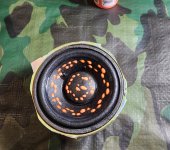I found it! Wharfedale Linton 3XP:I remember those midranges - my friend had Wharfedale speakers with them, I forgot the model, maybe Linton something. Many, many years ago.
Last edited:
I've had the materials for a long time, finally going to try doing a driver tonight. It's just a little 3" Malaysian Sony SS-MSP1 from a surround speaker from early 2000's.

Yes, as WF is a measurement presentation style and SW is a physical phenomenon. Do you att all master what you seem to lecture in...?Waterfall and standing waves
Most in this thread is bonkers...
//
58 years ago I got my first chisel-edged nib at my new school. they taught "italic" handwriting.
since then I've bought and used lots of these... for handwriting, which generally requires smaller widths on the order of 1mm, and for lettering which uses broader tips like those manufactured by Speedball.
my first pens were by Osmiroid but later "dip" nibs were by E.S. Perry and Mitchell.
I haven't bought these in a long time (arthritis had a say in that) so I don't know if they are still available or not.
on the other hand there are books available that describe how to cut your own chisel nib pens from a feather. Edward Johnson provided particularly clear instructions. ;-)
since then I've bought and used lots of these... for handwriting, which generally requires smaller widths on the order of 1mm, and for lettering which uses broader tips like those manufactured by Speedball.
my first pens were by Osmiroid but later "dip" nibs were by E.S. Perry and Mitchell.
I haven't bought these in a long time (arthritis had a say in that) so I don't know if they are still available or not.
on the other hand there are books available that describe how to cut your own chisel nib pens from a feather. Edward Johnson provided particularly clear instructions. ;-)
Dave,Not enuff spots, for that driverand likely wants 2 rings. A vsmaler nib would be required.
Lots opf practise is good, keep on truckin’
dave
I remember you mentioning in another thread that you ENAbl'd a Mark Audio MS11. Would you have any pics of that. When my work gets better that will be the first real drivers I ENAbl. Appreciate it!
- Home
- Loudspeakers
- Full Range
- EnABL-ing MAOP7
